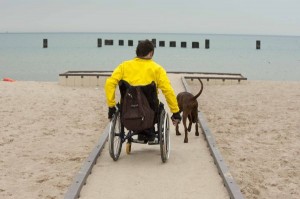Spinal injuries are very delicate and must be
looked after with the utmost care. I have looked after several patients with spinal injuries and it is important to know how to deal with them in the safest way. St Mark James First Aid Classes cover all the details needed to care for a patient with a suspected spinal injury.
A spinal injury can refer to one or more parts of the back and neck. This could be the bones, otherwise known as vertebrae, the discs, which are tissue separating the vertebrae, muscle or ligaments surrounding the spine, or the spinal cord itself and the nerves branching from it.
You should always suspect a spinal injury if the incident has involved abnormal forces on the back or neck, violent forward or backward bending or twisting. Particularly take note if the patient complains of any disturbance in feeling or movement.
Common causes of back injuries include:
- falling from a height
- falling awkwardly eg. during gymnastics/trampolining
- diving into shallow water and hitting the bottom
- being thrown from a horse or motorbike
- being in a collapsed rugby scrum
- sudden deceleration in a motor vehicle
- heavy object falling across their back
- injury to head or face
St Mark James Training says the biggest risk in a spinal injury is damaging the spinal cord. This can affect movement, sensation or power from the point of damage downwards. If the cord is partly or completely severed, the damage will be permanent and your patient will be paralysed.
However, displaced or dislocated discs or broken bones can pinch the spinal cord or its nerves which can cause temporary damage. First Aid Classes insist any patient with a suspected spinal injury must be transferred to hospital via specialists to be scanned to determine the exact problem.
First Aid Classes state the aims of a first aider with a spinal injury patient is to prevent further injury and to arrange specialist healthcare professionals to transport the patient to hospital.
You must avoid all unnecessary movement of the head, neck and spine at all times! Only move the patient if they are in danger, otherwise you must leave them in the same position you find them.
Continue to reassure the patient, and encourage them to stay still. Any movement increases risk of serious injury.
Kneel behind the patients head, and hold their head on either side, but don’t completely cover their ears as they will need to be able to hear you talking! Remain in this position supporting the head and neck in a neutral position, in line with the spine.

If in doubt, always suspect a spinal injury and take the necessary precautions. Remember, don’t move them unless it is absolutely necessary!
REFERENCES
First Aid Manual (The Authorised Manual of St. John Ambulance, St Andrew’s Ambulance Association and the British St Mark James), 2006.

